of Bosque Co., Texas
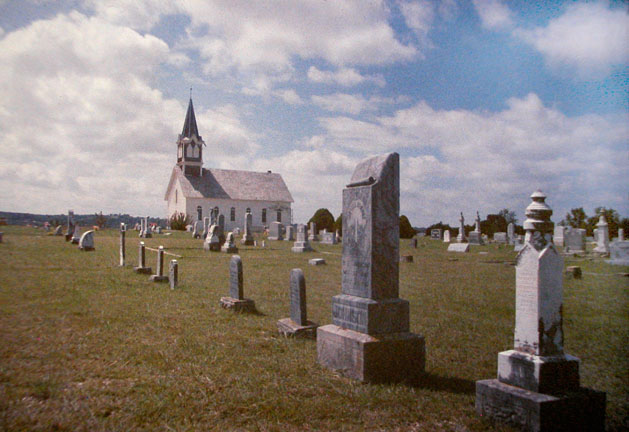
The Old Rock Church
The Old St Olaf's Lutheran Church, 1886
located four miles east of Cranfills Gap, Texas

The Texas Historical
Marker installed in 1974 states:
"built in 1886 of native stone by architect Andrew Mickelson and his brothers, Christian and Ole Michelson, it originally had a dirt floor and planks laid on wooden kegs for pews. The bell wsa acquired in 1897. The church served the Norwegian of settlers this area, who were members of Our Savior's Lutheran Church of Norse. In 1902, the growth of the community necessitated separation from the Norse church, and the St Olaf congregation was organized. A new edifice was erected in Cranfills Gap in 1917, and this church has since been used only for special services. "
The First Norwegian families
started coming to this area of Texas as early as 1841. The
State of Texas offered major land incentives for settlers of
Norway and Sweden. They were lead to Texas by a number of
Norwegian agents. The settlers for Bosque County were largely
brought her by Cleng Peerson who helped Norwegian settlements
across the United States.
An
article
in a newspaper in Louisiana is reprinted in The Evening Post, New
York, 13 Mar 1867 shows the process and attitude of the agents
and the expected settlers to Louisiana or Texas.
"First year the agency expense (sixty-five dollars in specie, or its equivalent in greenbacks), clothing and food, and thirty dollars in specie to the laborers, men and women the same." We bring on any kind of laborers employers may want, farmers, gardeners, women of all work, etc. For mechanics the prices will be somewhat higher than for field laborers.
"Second year, one hundred dollars and food and clothing for the men, and seventy-five dollars a year and food and clothing for the women.
Cleng Peerson found himself
in sympathy in Norway with the plight of the Quakers who were
being persecuted by the state Lutheran religion and locked
into an economic caste system. He started his investigation
for settlements to America on a three year journey on the
behalf of the Quakers. He encouraged the Quakers but also
promoted the economic opportunities and freedom to every
Norwegian. Although Cleng had obtained land for the new
settlers and went back to Norway to promote it, he returned to
the United States on a separate ship from the settlers.
The Quakers and Haugeans(a sect of pieist Lutherans), although
separate and competing religious organizations, had purchased,
refurbished, and sloop-fitted a twenty-four year old freight
hauling ship renamed as "the Restauration". It was only
54 feet long but was packed with 52 passengers. It left
Stavanger on July 4, 1825 and headed south to Madeira where it
was re-supplied. From there they took the easterly trade winds
to the Caribbean. This was a tiny ship for 53 men, women
and children who took 98 days for the journey to New
York. Cleng Peerson met the ship as promised but the
captain was temporarily arrested for overloading the ship.[Viking 23] The first colony of 52 immigrants
was settled in Kendal, New York. These first setters from
Norway have been known among themselves and Norwegians as
"Sloopers" for the sail configuration on the ship. When this
settlement appeared likely to fail Cleng started exploring
more territory in Indiana, Illinois, Wisconsin, Minnesota,
Iowa and Missouri. [The Norwegian Texans]
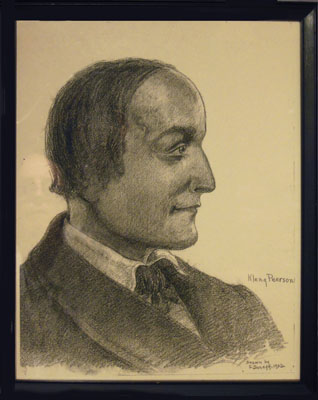 Cleng Peerson as remembered.
by I. Doseff, 1922
copy of the drawing in Bosque Museum, Clifton, TX |
The Restauration, as a postage stamp. The Centennial of the voyage, 1925. 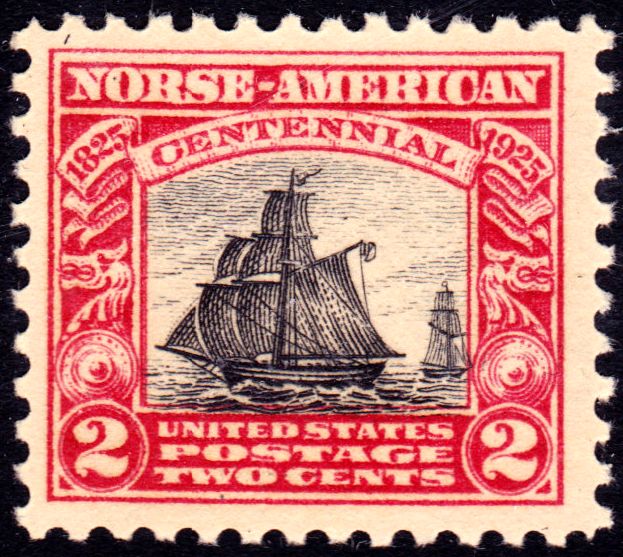 |
John Nordboe was the first settler in Texas in 1841. As a friend of Cleng Peerson and member of his first settlement in New York, his presence here apparently drew Cleng to explore Texas. In 1847 Cleng Peerson was 64 years old and had married a young Swedish woman in a communal settlement in Bishop Hill, Illinois. When the marriage failed he sold everything to bring a few families to Texas. He lived with the Ole Canuteson family, a neighbor to John Nordboe, ten miles south of Dallas for four years. [The Norwegian Texans]
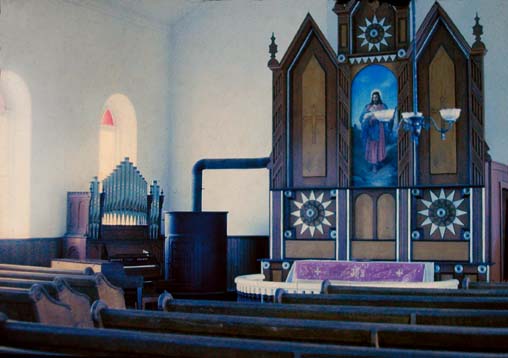 The
Altar
1912 - 2010
The
Altar
1912 - 2010
Bosque County was founded in 1854 by the State of Texas and offered 320 acres free to each settler. Cleng Peerson placed an ad in an Illinois newspaper and offered half of his land grant in the State of Texas in exchange for a home in his declining years. One particular method of getting from Illinois was by steamboat to New Orleans, then by ship to Galveston and then by oxcart to Bosque county. He lived with Ovee Colwick family near the Norse community a few miles southeast of Cranfills Gap until he died here in the Norse community, Dec. 16, 1865 where he is buried at the age of 82 in the Norse Cemetery. [Bosque Co. Hist., p35]
The Old Rock Church is situated on a rise overlooking Meridian
Creek valley. It was constructed in 1884 on land purchased for
$25. The main architect and builder was Andrew Michelson who
with the help of his brothers Christian and Ole, as well as,
many local farmers quarried the native limestone two miles
away. The stone had to be dressed and carted to the site where
the church was built in their spare time. The bell for calling
worship weighs 3200 pounds. It was lifted into place and the
remaining covering for the steeple was constructed around it.
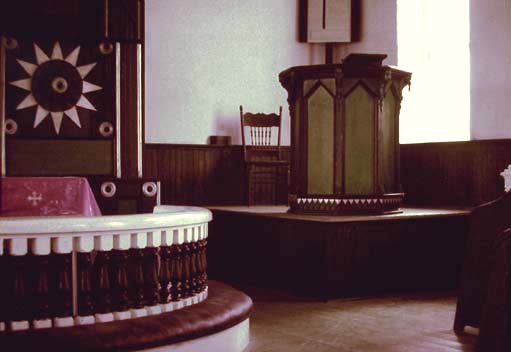
This was a true
Scandinavian community where Norwegian was the primary
language although there were Danes and Swedes here as well.
Even after the new church was constructed in Cranfills Gap
1917 we find that 44 services were held in Norwegian and only
22 in English. Still today it is well known for its
Septemberfest and the Lutefisk Dinners that the Lions Club
still puts on as an annual event for first Saturday in
December. Due the communities strong ties to its original
heritage this area was also visited by the King Olav V of
Norway on Oct. 10, 1982. He came to commemorate the birth of
Cleng Peerson and visited the Lutheran Church in the village
of Norse, which is very nearby. Here he placed a wreath on the
grave of Cleng Peerson. [Bosque Co. Hist. , p35]
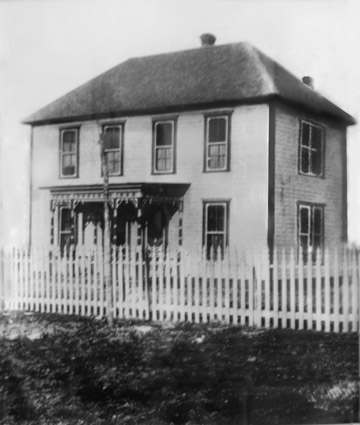 The pulpit
from c1912 -2010
The pulpit
from c1912 -2010
Until about 1920 a parsonage also stood near the church.
This photo hangs on the back wall of the church. I would
assume that the water for the church and the parsonage would
have to come from a hand dug well. I have seen no
sign of the original parsonage and I assume the well has long
been sealed.
The Restoration of the Rock Church.
Since my original photos included here on this page were taken
about 1995, there has been a major restoration. It has been
returned to its original colors which has been somewhat shocking
to those of us that don't remember the 1886 version. The
Rededication service of the church brought 400 guests on June 12,
2010. Wayne Rohne, who was involved in the work, explains
some of the logic around the changes.
" Two or three years ago, a noted
restoration architectural firm made an extensive study of the
Rock Church. Paint samples were taken and identified
through a process which is used at Home Depot, or Lowe's or many
paint stores. The colors inside and out at the Rock Church
should be close to the original 1886- or whenever the first
paint was applied.
Taking off the
plaster and getting down to the original rock on the
exterior was another effort at getting back to the
original. In this process some voids and cracks were
filled. A water resistant coating may be applied to the exterior
if this has not already been done
The major change in
the inside of the Church was installing the pulpit over the
altar where it was when the church was built in 1886. In
1912, a new pastor came to serve the congregation. He
thought it was presumptuous for a mortal such as he to be
over the Sacrament of the Altar-The Lord's Supper.
Some thought that the pastor felt that he would be more equal if
the pulpit were on a platform where it stayed until May 2010,
when it was removed to its original position.
The first Norwegian
Lutheran congregation in North America was organized in 1843 in
the Muskego community near Racine, WI. A church was built there
in 1839 by early pioneers. This church had the pulpit above the
altar. In 1904, the Muskego church was removed to the
campus of Luther Theological Seminary in St. Paul, Mn where it
is an historical landmark today. A large number of churches in
Norway have the pulpit above the altar. In this country,
the motivation for the
location is attributed to the followers of Hans Nielsen Hauge
who believed that the authority of the Word of God prevailed
over the formal worship service and the celebration of the
Sacrament of the Altar. I find this interesting. It
is probable that in 1912, Pastor Estrem was motivated by Haugean
thought as well-equality? In any event , two different
outcomes.
Some $228,000 has been spent at the Rock Church in the past two
or three years in enlarging the church grounds, for surveying,
fencing and the restoration.. I think it was and is a
magnificent effort. " [Wayne Rohne, 7/31/10]
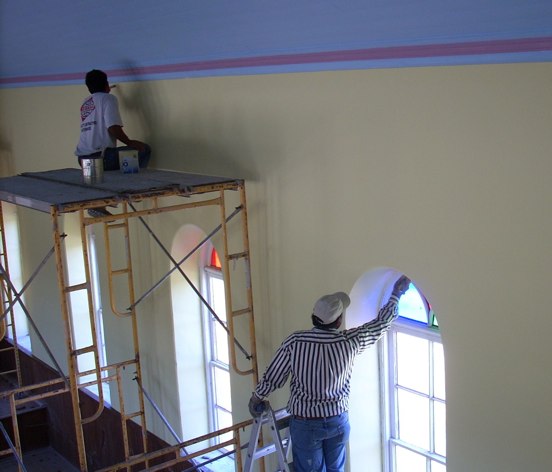
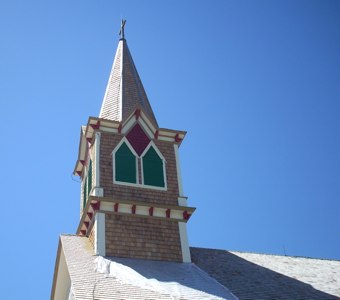
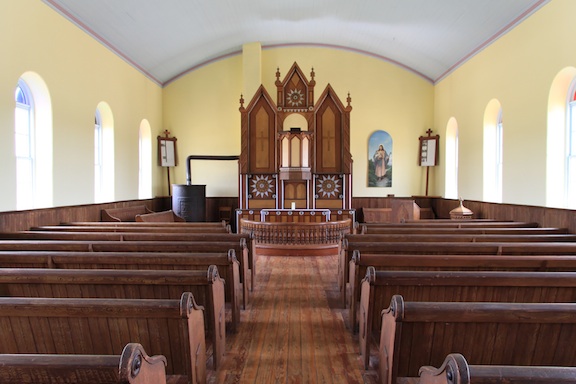
Many of the original
families of the region are buried in the cemetery adjacent to
this church. Here you will find Rohne,
Christenson, Johnson, Michelson, Bertelson but to name a
few. Andrew Michelson, the church builder and his brother,
returned to Norway after a few years and bought a farm in the
Løten Parish area. His heirs
are still there. [Michelson. email]
Cleng Peerson is buried only
a few miles from the Rock Church in the old town of Norse.
Here his fellow expatriates celebrated their good fortune when
the King of Norway visited his grave.

A monument at the Norse Church to the 17 original Norwegian
settlers in Bosque Co., TX in 1854,
For more cemetery listings use www.findagrave.com for the Saint
Olaf Cemetery, Bosque Co., TX.
PS: A reproduction of the
original Norweigian ship, "The Restauration" has been built by
Ryfylke Trebatbggjeri(Ryfylke Wooden Boatworks) in Finnøy,
Norway, not far from Stavanger. The reconstruction using
original techniques of the 1801 vessel cost NOK 8 million or
$1.3 million dollars in 2010. [Viking 25]
sources:
Elroy's Family Index || Ancestor Chart #1 || Regional History Index






All information and
photos included within these pages was developed by
the help of hundreds of researchers. The information
here is for the express purpose of personal
genealogical research and is freely offered as long as
this site is listed as a source. It may not be
included or used for any commercial purpose or
included in any commercial site without the express
permission of Elroy Christenson. Copyright Elroy
Christenson 1998-2013.